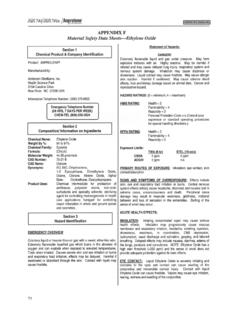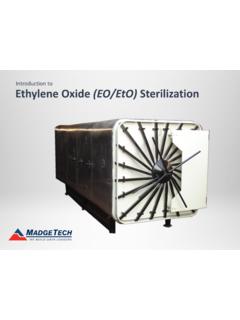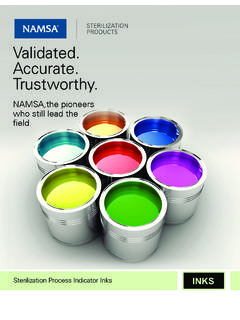Transcription of Draft Guideline for Disinfection and Sterilization in ...
1 1 HICPAC 2b CDC cleared 2/11/2002/WAR corrected and returned to CDC 2/20/2002 Draft Guideline for Disinfection and Sterilization in healthcare Facilities William A. Rutala, , , David J. Weber, , , and the healthcare Infection Control Practices Advisory Committee NOTE: This manuscript is a confidential communication. Do not duplicate, distribute, or quote until it is published. 2 EXECUTIVE SUMMARY ..7 DEFINITION OF A RATIONAL APPROACH TO Disinfection AND Sterilization ..10 CRITICAL SEMICRITICAL NONCRITICAL CHANGES IN Disinfection AND Sterilization SINCE 1981 (LAST CDC Guideline )..12 Disinfection OF healthcare CONCERNS WITH SPAULDING LAPAROSCOPES, ARTHROSCOPES, AND TONOMETERS, DIAPHRAGM FITTING RINGS, CRYOSURGICAL INSTRUMENTS, ENDOCAVITARY DENTAL DECONTAMINATION OF Disinfection OF HBV-, HCV-, HIV- OR TUBERCULOSIS-CONTAMINATED Disinfection OF HEMODIALYSIS INACTIVATION OF C.
2 INACTIVATION OF CREUTZFELDT-JAKOB DISEASE OSHA BLOODBORNE PATHOGEN EMERGING PATHOGENS (CRYPTOSPORIDIUM, HELICOBACTER PYLORI, ESCHERICHIA COLI O157:H7, HUMAN PAPILLOMA VIRUS, NORWALK VIRUS) ..23 TOXICOLOGICAL AND ENVIRONMENTAL Disinfection IN AMBULATORY CARE, HOME CARE, AND THE SUSCEPTIBILITY OF ANTIBIOTIC-RESISTANT BACTERIA TO SURFACE Disinfection : SHOULD WE DO IT? ..28 AIR MICROBIAL CONTAMINATION OF FACTORS AFFECTING THE EFFICACY OF Disinfection AND Sterilization ..30 NUMBER AND LOCATION OF INNATE RESISTANCE OF CONCENTRATION AND POTENCY OF PHYSICAL AND CHEMICAL ORGANIC AND INORGANIC DURATION OF 3 CLEANING ..32 Disinfection .
3 34 CHEMICAL Alcohol ..34 Mode of Action ..34 Microbicidal Chlorine and Chlorine Compounds ..36 Mode of Action ..36 Microbicidal Mode of Action ..38 Microbicidal Glutaraldehyde ..39 Mode of Action ..39 Microbicidal Hydrogen Mode of Action ..42 Microbicidal Mode of Action ..44 Microbicidal Ortho-phthalaldehyde ..44 Mode of Action ..44 Microbicidal Peracetic Acid ..45 Mode of Action ..45 Microbicidal Peracetic Acid and Hydrogen Peroxide ..46 4 Microbicidal Phenolics ..47 Mode of Action ..47 Microbicidal Quaternary Ammonium Compounds ..48 Mode of Action ..48 Microbicidal MISCELLANEOUS INACTIVATING Other Germicides.
4 49 Superoxidized Metals as Microbicides ..49 Ultraviolet Flushing- and Washer-Disinfectors ..51 EVALUATION AND NEUTRALIZATION OF Steam Microbicidal Mode of Action ..54 Flash Sterilization ..55 Low-Temperature Sterilization Technologies ..55 Ethylene Oxide "Gas" Sterilization ..56 Mode of Action ..57 Microbicidal Hydrogen Peroxide Gas Plasma ..58 Mode of Action ..59 Microbicidal Peracetic Acid Mode of Action ..60 Microbicidal 5 Microbicidal Activity of Low-Temperature Sterilization Technologies ..60 Bioburden of Surgical Effect of Cleaning on Sterilization Efficacy ..62 Other Sterilization Methods ..63 Ionizing Dry-Heat Sterilizers.
5 63 Liquid Chemicals ..63 Performic Microwave ..64 Glass Bead Sterilizer ..64 Vaporized Hydrogen Peroxide (VHP) ..64 Ozone ..65 Formaldehyde Steam ..65 Gaseous chlorine Vaporized Peracetic Acid ..66 Sterilizing Practices ..66 Sterilization Cycle Physical Facilities ..67 Cleaning ..67 Packaging ..68 Loading ..68 Storage ..68 Monitoring (Mechanical, Chemical, Biological Indicators) ..69 REUSE OF MEDICAL CONCLUSION ..73 RECOMMENDATIONS FOR Disinfection AND Sterilization IN healthcare FACILITIES ..74 A. B. C. 1. Cleaning of Patient-Care Equipment ..75 2. Indications for Sterilization , High-Level Disinfection , and Low-Level 3. Selection and Use of Disinfectants for Noncritical Patient-Care 4.
6 Disinfecting Environmental Surfaces in healthcare Facilities ..76 5. Disinfectant Fogging ..77 6. Management of Equipment and Surfaces in Dentistry ..77 7. High-Level Disinfection of 8. Processing Patient-Care Equipment Contaminated with Bloodborne Pathogens 79 9. Processing Creutzfeldt Jakob Disease (CJD)-Contaminated Patient-Care Equipment and Environmental Surfaces ..79 610. Disinfection Strategies for Other Semicritical 11. Disinfection in Ambulatory Care and Home Care ..81 12. Microbial Contamination of Disinfectants ..81 13. Flash 14. Methods of Sterilization ..82 15. Packaging ..82 16. Monitoring of Sterilizers ..82 17. Load 18.
7 Storage of Sterile 19. Quality Control ..83 20. Reuse of Single-Use Medical Devices ..84 21. Occupational Health and ACKNOWLEDGEMENTS ..84 Table 1. Methods of Sterilization and Disinfection ..92 Table 2. Properties of an ideal disinfectant..94 Table 3. Comparative frequency of infectivity in organs/tissue/body fluids of humans with transmissible spongiform encephalopathies..95 Table 4. Efficacy of chemical disinfectants in inactivating prions..96 Table 5. Efficacy of Sterilization processes in inactivating prions..97 Table 6. Epidemiologic evidence associated with the use of surface disinfectants or detergents on noncritical surfaces..98 Figure 1.
8 Decreasing order of resistance of microorganisms to Disinfection and Sterilization and the level of Disinfection or Table 7. Comparison of the characteristics of chemical sterilants used primarily as high-level disinfectants..100 Table 8. Summary of advantages and disadvantages of chemical sterilants used primarily as high-level disinfectants..102 Table 9. Summary of advantages and disadvantages of commonly used Sterilization Table 10. Examples of steam Sterilization parameters for wrapped or containerized Table 11. Examples of flash steam Sterilization Table 12. Characteristics of an ideal low-temperature Sterilization process..106 Table 14.
9 Comparative evaluation of the microbicidal activity of low-temperature Sterilization technology..108 Table 15. Suggested protocol for management of positive biological indicator in a steam 7 EXECUTIVE SUMMARY This Guideline for Disinfection and Sterilization in healthcare Facilities presents recommendations on the preferred methods for Disinfection and Sterilization of patient-care equipment based on the intended use of the item ( , critical, semicritical, and noncritical items). The chemical disinfectants recommended for patient-care equipment include alcohol, glutaraldehyde, hydrogen peroxide, iodophors, ortho-phthalaldehyde, peracetic acid, phenolics, quaternary ammonium compounds, and chlorine.
10 The choice of disinfectant, concentration, and exposure time is based on the risk of infection associated with the use of the equipment. The Sterilization methods discussed include steam Sterilization , ethylene oxide (ETO), hydrogen peroxide gas plasma, and liquid peracetic acid. When properly used, these cleaning, Disinfection , and Sterilization processes can ensure the safe use of invasive and noninvasive medical and surgical devices. However, this requires strict adherence to current cleaning, Disinfection , and Sterilization recommendations. INTRODUCTION Each year in the United States there are approximately 27,000,000 surgical procedures and an even larger number of invasive medical procedures 1.









